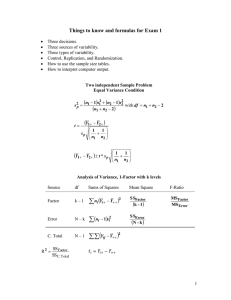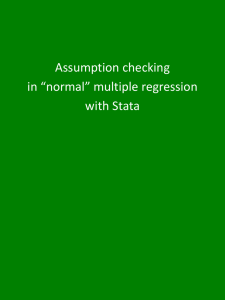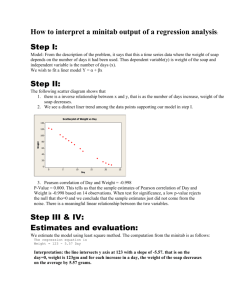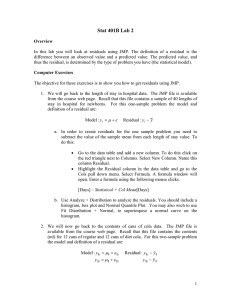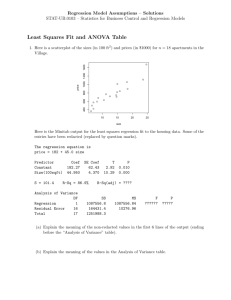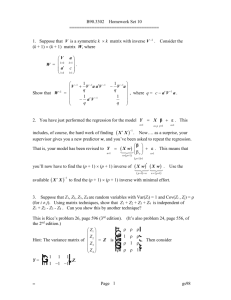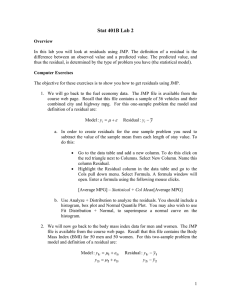Minitab Demonstration for Randomized Block Design
advertisement
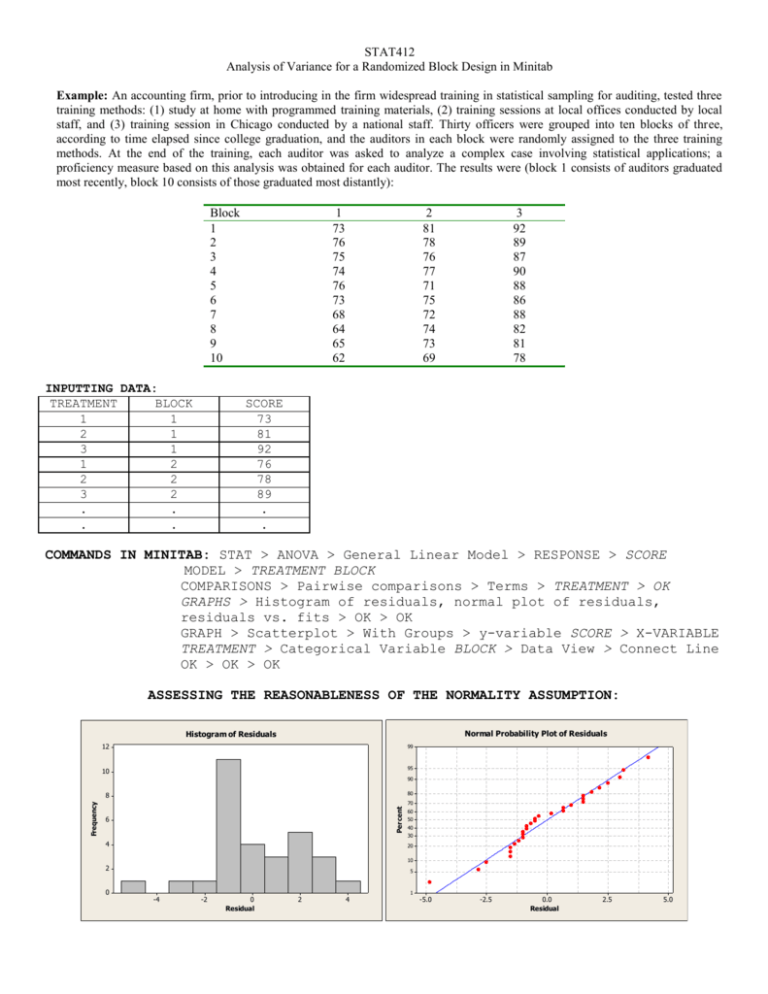
STAT412 Analysis of Variance for a Randomized Block Design in Minitab Example: An accounting firm, prior to introducing in the firm widespread training in statistical sampling for auditing, tested three training methods: (1) study at home with programmed training materials, (2) training sessions at local offices conducted by local staff, and (3) training session in Chicago conducted by a national staff. Thirty officers were grouped into ten blocks of three, according to time elapsed since college graduation, and the auditors in each block were randomly assigned to the three training methods. At the end of the training, each auditor was asked to analyze a complex case involving statistical applications; a proficiency measure based on this analysis was obtained for each auditor. The results were (block 1 consists of auditors graduated most recently, block 10 consists of those graduated most distantly): Block 1 2 3 4 5 6 7 8 9 10 INPUTTING DATA: TREATMENT BLOCK 1 1 2 1 3 1 1 2 2 2 3 2 . . . . 1 73 76 75 74 76 73 68 64 65 62 2 81 78 76 77 71 75 72 74 73 69 3 92 89 87 90 88 86 88 82 81 78 SCORE 73 81 92 76 78 89 . . COMMANDS IN MINITAB: STAT > ANOVA > General Linear Model > RESPONSE > SCORE MODEL > TREATMENT BLOCK COMPARISONS > Pairwise comparisons > Terms > TREATMENT > OK GRAPHS > Histogram of residuals, normal plot of residuals, residuals vs. fits > OK > OK GRAPH > Scatterplot > With Groups > y-variable SCORE > X-VARIABLE TREATMENT > Categorical Variable BLOCK > Data View > Connect Line OK > OK > OK ASSESSING THE REASONABLENESS OF THE NORMALITY ASSUMPTION: Normal Probability Plot of Residuals Histogram of Residuals 12 99 10 95 90 80 70 Percent Frequency 8 6 4 60 50 40 30 20 10 2 0 5 -4 -2 0 Residual 2 4 1 -5.0 -2.5 0.0 Residual 2.5 5.0 ASSESSING THE REASONABLENESS OF THE EQUAL VARIANCE ASSUMPTION: Residuals Versus Fits 5.0 Residual 2.5 0.0 -2.5 -5.0 60 65 70 75 80 Fitted Value 85 90 ASSESSING THE APPROPRIATENESS OF THE NO INTERACTION ASSUMPTION: The Scores for Each Method by Block 95 block 1 2 3 4 5 6 7 8 9 10 90 score 85 80 75 70 65 60 1 2 treat 3 Interpretation: From the appearance of the graphs, the normality and equal variance assumptions are reasonable. There is some concern, however, about the appropriateness of the no interaction assumption. Now we perform an analysis for a randomized block design. Minitab Output for Performing Analysis for Randomized Block Design: Analysis of Variance for score, using Adjusted SS for Tests Source treat block Error Total DF 2 9 18 29 S = 2.49815 Seq SS 1295.00 433.37 112.33 1840.70 Adj SS 1295.00 433.37 112.33 R-Sq = 93.90% Adj MS 647.50 48.15 6.24 F 103.75 7.72 P 0.000 (H0: 1.=2.=3.) 0.000 R-Sq(adj) = 90.17% Unusual Observations for score Obs 5 15 score 76.0000 71.0000 Fit 71.8333 75.8333 SE Fit 1.5800 1.5800 Residual 4.1667 -4.8333 St Resid 2.15 R -2.50 R R denotes an observation with a large standardized residual. H0: 1=2=3 Ha: At least two of the treatment means are different. =.05 F=103.75 p-value=.000 < thus reject H0 Conclusion: The data provide sufficient evidence to conclude that at least two of the treatment means are different. Now we will apply Tukey’s multiple comparisons procedure to locate which treatment means are different. Grouping Information Using Tukey Method and 95.0% Confidence treat 3 2 1 N 10 10 10 Mean 86.1 74.6 70.6 Grouping A B C Means that do not share a letter are significantly different. Tukey 95.0% Simultaneous Confidence Intervals Response Variable score All Pairwise Comparisons among Levels of treat treat = 1 subtracted from: treat 2 3 Lower 1.148 12.648 treat = 2 treat 3 Center 4.000 15.500 Upper 6.852 18.352 --------+---------+---------+-------(-----*-----) (-----*-----) --------+---------+---------+-------5.0 10.0 15.0 subtracted from: Lower 8.648 Center 11.50 Upper 14.35 --------+---------+---------+-------(-----*-----) --------+---------+---------+-------5.0 10.0 15.0

